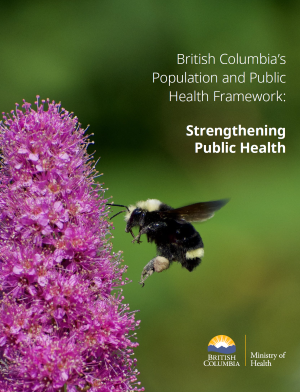B.C.'s Population and Public Health Framework
In 2024, the Ministry of Health released a new provincial strategy for population and public health in B.C.
On this page
Population and Public Health Framework
In 2024, the B.C. Ministry of Health released British Columbia's Population and Public Health Framework: Strengthening Public Health (PDF, 5.9MB). The renewed provincial strategy outlines the long-term vision and strategic direction for population and public health in B.C.
The role of public health is to promote and protect the health and well-being of all people in B.C. The term "public health" is often confused with the publicly-funded health care system in Canada. Public health is one important part of this publicly-funded health care system.
Foundational Principles

Three Foundational Principles have been identified in B.C.'s Population and Public Health Framework (the Framework). Each principle represents a lens that is incorporated across the Framework.
Truth, Rights and Reconciliation
- Take concrete actions to dismantle Indigenous-specific racism in the population and public health system
- Uphold Indigenous Rights and advance Truth and Reconciliation
- Honour Indigenous knowledge and wisdom by acknowledging the interconnectedness of human health, the health of communities and the health of lands and waters
Health Equity and Anti-Racism
Influence the social, ecological and structural determinants of health to take action on systemic racism within population and public health and work to eliminate preventable health disparities so that no one is left behind.
System Capacity
Strengthen the core public health functions and enabling functions that support population and public health teams to promote health and wellness, prevent disease and injury, protect health, and respond to evolving population needs, including to emerging threats.
Priorities

The Framework identifies six population and public health priorities. These priorities represent the key areas where sustained and coordinated action are needed across the sector.
Best Start in Life
Build foundations of good health by reducing unfair disadvantages for pregnant people, children and families.
Communicable Disease Prevention and Response
Mitigate health and societal impacts from communicable diseases and prepare for any future pandemic.
Health Impacts of Climate Change
- Anticipate, assess, prevent and reduce the human health impacts and hazards from climate change, recognizing the interconnectedness of human health and the health of the environment
- Support climate change adaptation, resiliency and mitigation activities that protect populations
Non-Communicable Disease and Injury Prevention
Prevent and reduce the impacts of non-communicable disease and injury.
Population Mental Health and Wellness
Improve the mental health and wellness of the population, including by cultivating connection to land, language, place and community.
Prevention and Reduction of Substance-Related Harms
Prevent and reduce harms of legal and illegal psychoactive substances.
Functions

There are two sets of functions for population and public health:
Together the functions provide an integrated structure to help public health define, plan, deliver and orient health systems towards population health and well-being.
Core Public Health Functions
Core public health functions are the key strategies and activities that are fundamental to achieving population health. In B.C., there are six core public health functions:
Health Promotion
Enabling people to increase control over and improve their health and well-being through individual and collective action on the determinants of health.
Healthy Public Policy
Coordinating action across sectors to ensure that health impacts of decisions are factored into public policies.
Health Protection
Working to ensure healthy air, food, drinking water and environments to sustain healthy people and thriving communities.
Public Health Emergency Preparedness and Response
Developing the capacity to mitigate, prepare for, respond to and recover from health emergencies.
Disease and Injury Prevention
Measures to reduce the risk and occurrence of communicable and non-communicable diseases, illnesses and injuries, and to create the living conditions that support health and wellness.
Public Health Intelligence
Ongoing collection, analysis, interpretation and mobilization of population health data with the intent to improve health and with a commitment to Indigenous data sovereignty.
Enabling Functions
Enabling functions represent the underlying structures, resources or building blocks that need to be in place to enable the effective delivery of core public health functions. The enabling functions are not unique to public health and are needed to establish and maintain the capacity of the system. In total, 6 enabling functions have been identified:
Data, Analytics and Infrastructure
Creating and supporting integrated, interoperable population health systems that provide data for timely use and analysis.
Resource Management
Planning, financing and coordinating population and public health resources.
Governance, Legislation and Regulation
Ensuring effective health governance, policy and legislative infrastructure, including commitments outlined in the Declaration on the Rights of Indigenous Peoples Act.
Public Health Workforce
Ensuring that the workforce has the right scale, knowledge, skills and capacities to fulfill all core public health functions in trauma-informed, person-centred, culturally safe and anti-racist ways.
Intersectoral Collaboration and Community Mobilization
Working together across sectors and communities to advance population health.
Evidence, Knowledge and Communication
Promoting, facilitating and communicating evidence-informed decision-making that upholds Indigenous knowledge systems and other diverse cultural values and beliefs, to transform knowledge into action and enable a learning public health system.
Our partners
Development of the Framework was led by the Ministry of Health’s Population and Public Health Division and the Office of the Provincial Health Officer, with support from public health leaders and experts in B.C. It involved extensive consultation with population and public health partners—the five regional health authorities, First Nations Health Authority and the Provincial Health Services Authority (through the BC Centre for Disease Control)—and with other sectors.
Learn more about public health and why it is important.

